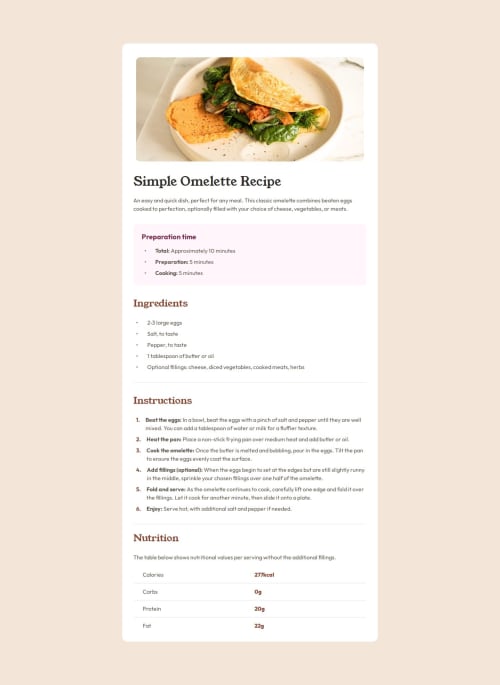Recipe Page - HTML, CSS And Flexbox

Solution retrospective
The challenge was mostly basic stuff. The only thing to mention here is the customized lists styling and the use of CSS counters.
What specific areas of your project would you like help with?I’d just like some tips on best practices or things to avoid. Any advice on common mistakes and how to do things the right way would be awesome!
Please log in to post a comment
Log in with GitHubCommunity feedback
- P@Stroudy
Hey Great job with this challenge, Nothing wrong but some things to consider,
- Having better
alt=""descriptions for accessibility is a must check this out Write helpful Alt Text to describe images, - Should take a look at BEM naming convention for class names, Its really useful and practical,
- You have used
<div>underinstructionsfor your paragraphs, you should wrap them in<p>to make them semantically correct, - You should apply a full modern reset to make things easier as you build, check out this site for a Full modern reset
- In your
<atricle>you have set a width inpxand your@media, Check out this article from a Frontend mentor dev about responsive-meaning. - Using
max-width: 100%ormin-width: 100%is way more responsive than justwidth:100%, - It would not be a bad idea to download the fonts in
.woff2format, Host it your self using a@font-faceand add afont-display: swap;property, To leverage the font-display CSS feature to ensure that text is user-visible while web fonts are loading, Increasing performance.
Happy coding, will be good to see some more from you.
Marked as helpful - Having better
- @TedJenkler
Nice job, keep going!
Join our Discord community
Join thousands of Frontend Mentor community members taking the challenges, sharing resources, helping each other, and chatting about all things front-end!
Join our Discord